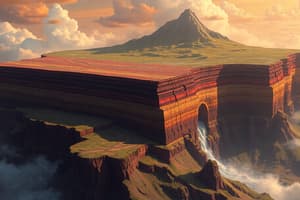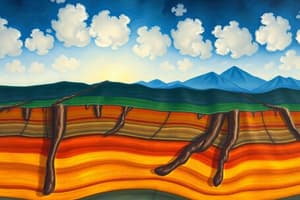Podcast
Questions and Answers
What is the primary characteristic of the lithosphere?
What is the primary characteristic of the lithosphere?
- It is completely molten and flows.
- It is hard and forms the Earth's crust. (correct)
- It consists of liquid magma.
- It is the densest part of the Earth.
Which of the following best describes convergent plate boundaries?
Which of the following best describes convergent plate boundaries?
- Plates sliding past each other.
- Plates moving towards each other. (correct)
- Plates moving apart from each other.
- Plates floating unconnected on the mantle.
Which evidence supports the theory of plate tectonics?
Which evidence supports the theory of plate tectonics?
- Diverse climate conditions across continents.
- The consistent temperature of the Earth's core.
- Ancient fossils and rocks found on distant continents. (correct)
- Modern geological mapping of continents.
What geological features do oceanic and continental plate convergence typically produce?
What geological features do oceanic and continental plate convergence typically produce?
What occurs at hotspots in the Earth's lithosphere?
What occurs at hotspots in the Earth's lithosphere?
Which type of crust is denser and sinks during subduction?
Which type of crust is denser and sinks during subduction?
What is the result of two continental plates colliding?
What is the result of two continental plates colliding?
Who first proposed the Tectonic Plate Theory?
Who first proposed the Tectonic Plate Theory?
What is a primary effect of divergent plate boundaries on oceanic regions?
What is a primary effect of divergent plate boundaries on oceanic regions?
What is a common consequence of a transform plate boundary?
What is a common consequence of a transform plate boundary?
During subduction at convergent plate boundaries, what typically occurs?
During subduction at convergent plate boundaries, what typically occurs?
What measurement tool is used to record seismic activities during earthquakes?
What measurement tool is used to record seismic activities during earthquakes?
Which type of eruption is characterized by violent explosive activity?
Which type of eruption is characterized by violent explosive activity?
What happens to global temperatures as a result of volcanic ash and gases after an eruption?
What happens to global temperatures as a result of volcanic ash and gases after an eruption?
What geological feature is commonly formed due to the collision of two continental plates?
What geological feature is commonly formed due to the collision of two continental plates?
What phenomenon can be triggered by underwater fault slips during an earthquake?
What phenomenon can be triggered by underwater fault slips during an earthquake?
Which phenomenon is not typically associated with transform plate boundaries?
Which phenomenon is not typically associated with transform plate boundaries?
What is a significant effect of tectonic plate movements on global supply chains?
What is a significant effect of tectonic plate movements on global supply chains?
Flashcards
Plate Tectonics
Plate Tectonics
The theory that Earth's lithosphere is broken into plates that move over the asthenosphere.
Lithosphere
Lithosphere
The hard, rigid outer layer of the Earth, made up of crust and upper mantle.
Convergent Boundary
Convergent Boundary
Where two tectonic plates collide.
Subduction
Subduction
Signup and view all the flashcards
Continental Crust
Continental Crust
Signup and view all the flashcards
Oceanic Crust
Oceanic Crust
Signup and view all the flashcards
Hotspots
Hotspots
Signup and view all the flashcards
Asthenosphere
Asthenosphere
Signup and view all the flashcards
Divergent Plate Boundary
Divergent Plate Boundary
Signup and view all the flashcards
Mid-Ocean Ridges
Mid-Ocean Ridges
Signup and view all the flashcards
Rift Valleys
Rift Valleys
Signup and view all the flashcards
Transform Plate Boundary
Transform Plate Boundary
Signup and view all the flashcards
San Andreas Fault
San Andreas Fault
Signup and view all the flashcards
Convergent Plate Boundary
Convergent Plate Boundary
Signup and view all the flashcards
Collision
Collision
Signup and view all the flashcards
Volcanic Arcs
Volcanic Arcs
Signup and view all the flashcards
Earthquake Mechanism
Earthquake Mechanism
Signup and view all the flashcards
Study Notes
Earth's Layers and Plate Tectonics
- The Earth's lithosphere is a hard, rigid outer layer broken into plates
- The asthenosphere is the soft, partly molten layer below the lithosphere
- The mesosphere is the mostly solid lower mantle
- These layers move in convection currents
- Continental crust and oceanic crust are different types of crust
- The theory of plate tectonics proposes plates on the asthenosphere move, interact, and cause major geological events
- Evidence for Plate Tectonics
- Continents fit together like puzzle pieces (Pangea)
- Fossils and rocks found on distant continents
- Earthquakes, volcanoes, and mountain ranges occur at plate boundaries
- Plate Boundaries
- Convergent: occurs when two plates collide
- Oceanic-Oceanic: Older, denser oceanic crust subducts under the other
- Oceanic-Continental: Oceanic crust subducts under continental crust
- Continental-Continental: neither plate subducts causing mountains
- Divergent: occurs when two plates move apart
- Transform: occurs when two plates slide past each other
- Convergent: occurs when two plates collide
- Hotspots
- Areas of volcanic activity not at plate boundaries
- Caused by magma plumes rising from the mantle
- Examples include Hawaiian Islands, Yellowstone National Park
Studying That Suits You
Use AI to generate personalized quizzes and flashcards to suit your learning preferences.




